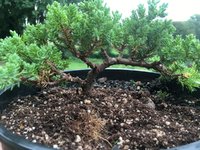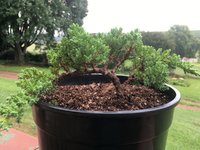Matthew Rudling
Sapling
I have three juniper procumbens nana - really small. Two of them are each half a pencil in diameter. The third is about a pencil and a bit. My question is, do you wire the trees at this stage, or is it better to let them grow wild for a few years and perhaps wire along the way once they get taller and larger diameter so you have more to work with? My ultimate height for the trees would be no more than 30cms given that they are slow to thicken up at the base.
My plan is to style them into cascades or semi-cascades, or perhaps informal uprights.
I have tried wiring one of the smaller ones and it felt as if the tree was too small to do so at this stage because the wired proportions felt like they would only fit a very small tree given that the bends etc were too small.
The largest of the three is posted below (front and back at for want of a better term of view):


My plan is to style them into cascades or semi-cascades, or perhaps informal uprights.
I have tried wiring one of the smaller ones and it felt as if the tree was too small to do so at this stage because the wired proportions felt like they would only fit a very small tree given that the bends etc were too small.
The largest of the three is posted below (front and back at for want of a better term of view):


